Tanya Rogers FSU Coastal & Marine Lab


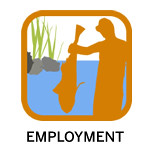 (Editor’s Note. Although David refers to Randall’s participation on this study, her role was not elaborated upon in this video. That will be a part of the next video, on David’s collaborators, as Randall is David’s Co-PI- or Primary Investigator)
(Editor’s Note. Although David refers to Randall’s participation on this study, her role was not elaborated upon in this video. That will be a part of the next video, on David’s collaborators, as Randall is David’s Co-PI- or Primary Investigator)
It’s been said that research techs are those who do the dirty work in science. Although true in many ways, I love being where the action is, collecting the data, turning ideas into reality. That said, here is some of my perspective on what went into our October trip and what days in the field were like.
A busy field trip like our October sampling push typically takes at least as many days to prepare for as the length of the trip itself. Although the daily blog posts covered our time in action, David and I spent most of the previous couple weeks just planning for this trip so that it could run as smoothly as it did. I feel it worth mentioning the many hours I spent pouring over tide charts and editing and re-editing our complicated schedule so that we could accomplish everything as efficiently as possible, factoring in all manner of time and tidal constraints, travel time, land and sea transportation, overnight stays, and numerous other variables, plus designing it with enough flexibility that we could adjust our plans in the field at a moments notice (and indeed we did). In addition to scheduling I also had to make sure we had all the materials we needed to for our trip, that those materials were all in working order, and that they are all packaged up accordingly and conveniently in our two vehicles. The last thing you want is to be out in the field and realize you’re missing some critical piece of equipment.
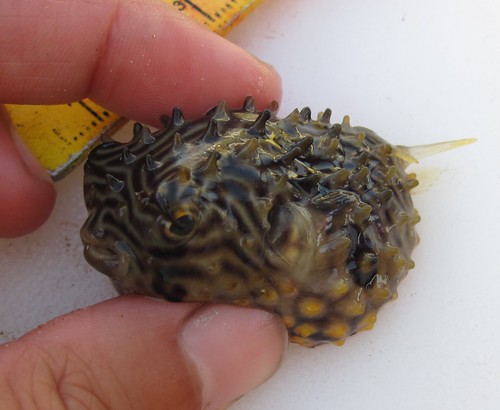
As they conduct these initial sampling trips every few months, they keep finding new and interesting species living in and around the reefs. Here, Tanya is taking measurement of one of her favorite finds of this last trip, a striped burrfish.
Out in the field, going to retrieve our traps and nets is always the most exciting for me, since you never know what we’re going to catch, and I was interested to see how the October fish community compared with that of July. We caught a few new fish species in our traps this round, including a beautiful spotfin butterflyfish (Chaetodon ocellatus), juvenile snapper (Lutjanus sp.), and a couple tiny pufferfish (technically striped burrfish, Chilomycterus schoepfi – they were very adorable). Equally exciting was getting to use the new motor on our skiff for the first time at our sites. Although noisy and bizarre-looking, it performed admirably in shallow water, as it was designed to. At least in terms of temperature and humidity, conditions on the reefs were considerably more pleasant for us than during the summer. It was wonderful not to be wiping sweat from your face every 10 minutes. The dramatic increase in the no-see-um population at dawn and dusk was not so pleasant however, as David has duly noted. The dawn low tide at Jacksonville brought the worst swarms we’d ever encountered in the field. Incredibly irritating both physically and mentally, they made work nearly impossible, and forced me to spend the subsequent week covered in uncountable numbers of ravenously itchy welts.
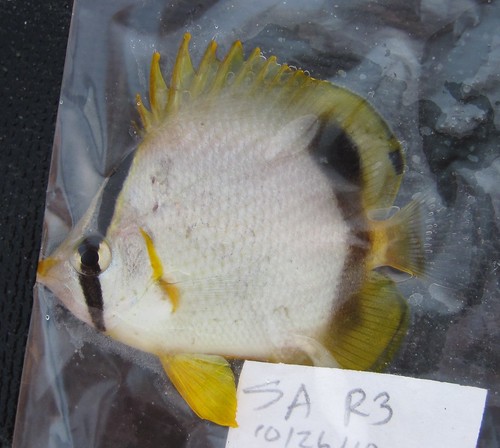
Despite its exotic look, the spotfin butterfly fish is a native of both the Gulf and Atlantic coasts of Florida.
When not out on the reefs, there was rarely a moment when something didn’t need to be done – whether filtering water samples, rinsing gear, or (most frequently) extracting spat. Our only breaks seemed to be for the necessities of eating, showering, sleeping, and making coffee. (For David, coffee appears to rank just below data and samples in terms of his most valued possessions in the field.) Our biggest and most time-consuming challenge was whether we could get all of the spat extracted and tiles made for our predator-exclusion experiment in the time allotted between netting and trapping. The process of isolating spat was incredibly tedious to say the least, and particularly frustrating when, after you’ve been working on a spat for several minutes, your tool slips and the spat gets crushed, or it flies across the patio, never to be seen again. You couldn’t help but feel the spat always picked the most inconvenient places to settle. It was also quite a messy process, with water and oyster bits flying everywhere and various crabs skittering across the counter. The oysters also love to slice your fingers open during the few moments when you neglect to wear gloves. Yet in spite of the tedium, we couldn’t help noticing new and interesting critters living amongst the oysters as we broke them apart. For instance, we noticed considerably more porcelain crabs (Petrolisthes sp.) and Boonea impressa (a small, white snail that parasitizes oysters) than we’d seen in previously collected oyster samples. We also found an oyster pea crab (Pinnotheres ostreum), which lives on and steals food from the gills of oysters, and a number of dark brown cylindrical mussels (Lithophaga bisulcata) that bore into the calcareous shells of oysters. It always amazes me how many different animals can be found living within the structurally complex habitat created by species like oysters.
I remember on one of the last days of our trip, I kayaked out to our St. Augustine reefs for a final service and check while David finished up the dremeling. I remember looking upon reef #5, seeing our newly deployed, spat-covered tiles and cages, our cleaned tidal data logger housing, and our newly replaced spat stick, arranged so neatly on our marked reef, and feeling delighted at our accomplishment, knowing how much effort has gone into this setup. I remembered that in my position it’s easy to get sucked into the details, but it’s equally important to remember the big picture, and how this research will contribute to our greater understanding of oyster reef ecology.
After our field trip, as we recover from battle wounds and wait for the mud to work its way out from under our fingernails, work on the oyster project continues at the lab. For me this has meant entering lots of data and starting to process our many samples. Before you know it though, it’s time to start to preparing for our next journey onto the reefs and the adventures that await.

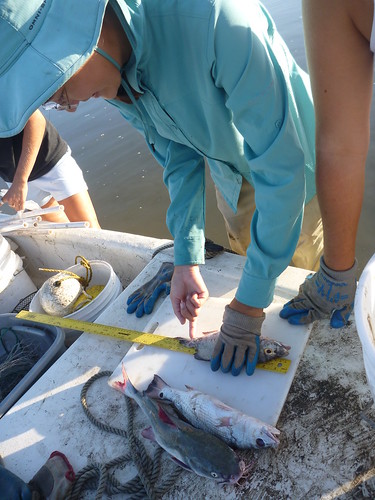
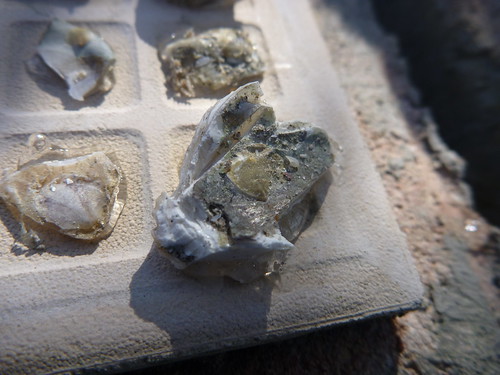
4 comments
[…] project during the winter gave rise to my love of coffee (as Tanya eloquently captured in her last post), and it bugged the crap out of Jon…that and my caffeinated singing of 80’s songs in his lab […]
[…] heard about research from a lab tech’s perspective from Tanya, and from a Principle Investigator (PI)’s perspective from Randall and David, so I thought I’d […]
[…] fish that the Kimbro crew has caught on some of their oyster reefs, and which Tanya has stated in a previous post is one of her favorites as well. I’m talking about the striped burrfish. This one is a […]
[…] work in genetics. In David’s lab, we’ve heard from Tanya Rogers, a lab technician who keeps David’s lab organized, and who is crucial in the planning and implementation of their large field experiments. We have […]
Comments are closed.